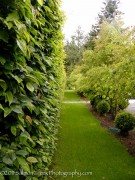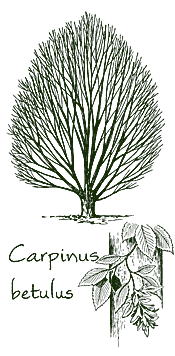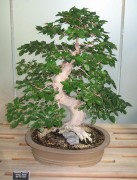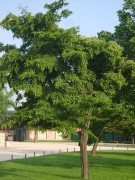Carpinus
Hornbeam
Scattered across temperate areas of the northern hemisphere, with most species populating east Asia, this fairly small deciduous genus is noteworthy for its hard timber, simple, neatly pleated leaves, hop-like fruiting clusters and understated elegance. Hornbeam’s urbane rich green foliage embellishes an undemanding long-lived habit that appreciates moderate moisture, but tolerates occasional dry conditions once established plus clay and alkaline soil.
Each $26.75


Renown for the grand forest-green hedges it fashions, European Hornbeam premiers glistening tight-knit pleated leaves, and when left unclipped develops a dense pyramidal to rounded silhouette. The toothed oval-shaped foliage takes on splendid buttery yellow fall color against smooth gray bark inscribed with muscular vertically aligned undulations. Enduring wind, heavy pruning and clay soil, cold-hardy Carpinus betulus can be showcased as a hedge, windbreak, single specimen, or planted in an allée, pleached or not. 10´ in 10 years. Large Band.
Blooms March
Size: 40' 0" – 60' 0" high x 20' 0" – 30' 0" wide.
Hardy to zone 5.

While its common name alludes to the notable smooth bark that’s layered with sinewy undulations upon maturity, the cultivar name announces the blazing red and tangerine fall finale it delivers. This small-statured decidious eastern American native fashions a dense, broadly globe-shaped canopy defined by nutlets amid handsome, prominently veined dark green leaves. Meticulously selected by Wisconsin’s Musclewood enthusiast Michael Yanny, Wisconsin Red™ ‘MY Select Strain’s undemanding habit savors sun or bright dappled light plus adequately moist well-drained haunts, endure clay and walnut soil and lends untold beauty to any garden, especially small residential spaces and woodland plantings.
Size: 15' 0" – 20' 0" high x 10' 0" – 15' 0" wide.
Hardy to zone 3.
Each $26.75
Native to Japan, Korea and China, this slow-growing, small rounded tree draws attention throughout the seasons. Lovely, large heart-shaped dark green leaves with doubly serrated margins and prominent veins lend a graceful quality amid densely-set branches. Big fruiting catkins and sizable cigar-style seed pods provide additional intrigue, while chunky winter buds and unique scaly, fissured coal-gray bark etch the cold weather landscape. Once utilized in crafting agricultural tools and furniture, Heartleaf Hornbeam’s easy-care habit can be planted as a sentinel, deciduous screen or small specimen in space-thrifty gardens and woodland settings where dappled shade plus organic-rich soil ensure its longevity. Large Band.
Size: 20' 0" – 30' 0" high x 12' 0" – 15' 0" wide.
Hardy to zone 5.
Each $26.75

Cherished among bonsai devotees, this graceful multi-stemmed Korean native deserves a prominent place in more landscapes as a small-scale ornamental specimen. Pendulous branches taper into short shrubby, deep brown twigs that are infused with wine hues. Sporting a lustrous spring and summer sheen, the serrated tiny green deciduous leaves orchestrate a fantastic fall finale of flaming red, yellow and orange colors. Appreciative of some protection from hot afternoon sun, especially in dry locations, C. coreana’s refined slow-growing visage can flourish near a bench, a terrace or even in a large container, while its strong growing roots can survive occasional drought. Grows slowly.
Blooms March
Size: 15' 0" – 20' 0" high x 12' 0" – 15' 0" wide.
Hardy to zone 5.
OUT OF PRODUCTION AT THIS TIME
Email me when this plant is available

This stellar medium-sized Hornbeam promises to delight all year round. Hallmarking spring and summer, a winsome bevy of small, oval-shaped dark green serrated foliage sport prominent veins, soft yellow-green undersides and slender pointed tips. Long, pendent, bright green and red-tinged fruiting keys accompanied by cozy yellow and red foliage make attractive autumn features, while winter showcases pendulous branches and smooth pale patterned bark.
A rarely offered Japanese native introduced in 1914, the versatile Carpinus laxiflora can be grown as a landscape specimen or serves as an ideal bonsai candidate. 10' in 10 years. Large Band.
Blooms March.
Size: 30' 0" high x 20' 0" – 25' 0" wide.
Hardy to zone 6.












